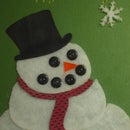Introduction: Wooden French Curves - Made at Techshop
In this instructable I'll show you how I made a set of wooden french curves using the scroll saw at Techshop's wood shop.
French curves are very handy drafting tools, and for woodworkers they are great to have around the shop to lay out simple and attractive free-form curves on projects. I've bought several sets of acrylic curves from local art stores - they last me a while, but I inevitably lose or break them.
The clear plastic is useful, because it allows you to see the lines you've already drawn through the curves, and line up complex shapes accurately. But wooden curves are fine for laying out simple curves - for furniture, bandsaw projects, or organic accents. I decided to make these out of wood mostly as an exercise to get me started using the scroll saw - they are a good way to practice a variety of cuts on the scroll saw. They also look neat, and in general I like using tools that I made myself around the shop.
P.S. If you like what you see, vote for me in the full-spectrum laser contest and / or woodworking contest!
Step 1: Tools and Materials Used
Tools used
- Scroll saw - DeWalt
- #6 skip tooth blade - from Olsen
- #2 fine tooth blade - also Olsen
- Adobe Illustrator (to create clean lines for a pattern). Inkscape is a free, open-source alternative.
Materials used
- Scrap wood - black walnut (also pictured, peruvian walnut & ash wood)
- Sandpaper - 80, 120, 320 grit
- Deft semi-gloss Clear Wood Finish - a sprayable aerosol lacquer
- Printed paper pattern
- Spray adhesive
Optional, but helpful
As you can see in the second picture, I'm sporting some serious safety gear.
- Eyeglasses are always a good idea when working with power tools. Not essential with the scroll saw, but since Techshop is a shared workspace they also protected me from the guys using the table saw and lathe in the same room as me.
- Respirator or dust-mask can be helpful if you're cutting for an extended time. Peruvian walnut in particular releases fine dust that, while smelling nice, can irritate the nose and throat.
- Ear-protection. Not so much a safety concern - the scroll saw shouldn't be loud enough to damage your hearing - or you're probably doing something wrong. However, they really help me block out the rest of the world and focus better on controlling my workpiece. I often pair them with some headphones and music that helps me focus.
Step 2: Plan the Curves, Print the Patterns
There are dozens of styles of french curves out there, for a good source of shapes I went to the Wikipedia article on French Curves. The article includes a chart with all the curves from something called the Burmester set. Most art stores sell a set of 3 common curves - I chose to use these 3 curves along with one more intricate design.
I imported the Wikipedia image into Illustrator and used the live-trace feature to change the shapes into clean vector lines. This made them easy to sort through and resize as necessary. You could also skip this step and just crop your desired shapes from the image. I've made a detailed walkthrough of how I converted the curves - see the pictures in this step. I've also included my own Illustrator file with the vector lines.
Once you have the shapes you want isolated, print them out and stick them to your wood blanks. The size of your pattern and your blanks really depends on what work you plan to do - if you layout lots of small projects like me, or want to use them for drawing, it's probably good to have some smaller versions. However, if you plan to use them for large furniture projects or large-scale drafting, then make them larger.
I stuck my patterns to the wood with spray adhesive. Techshop has something called Ace #27. 3M's Super 77 is another good choice, and what I normally use. If you don't have or don't want to use spray adhesive, I believe a glue-stick will also work fine.
Attachments
Step 3: Mount Pattern & Drill Entry Holes
First I mounted the patterns on each piece of wood to be cut. I used 3M77 spray adhesive - it is tough enough to stand up under rough handling, but easy to remove completely with just a bit of mineral spirits once all the parts are cut.
Next, I drilled entry holes for each of the inside details - these holes create a place to insert the scroll saw blade for cutting out each section, without having to enter from the side of the shape. All the inside pieces are waste pieces, so the size of the hole doesn't matter much - any hole that allows the blade through should work.
Step 4: Cut the Outside Shapes
I started by cutting the outside shape of each curve. I didn't try to follow the curve all the way around, but cut away the outside in several sections rather than twist and turn the blade around in the work. I tried to cut right on the line, but if I felt myself straying, I tried to err on the side of caution and cut on the outside of the line - leaving myself space to sand away later instead of cutting into my finished piece.
I started with the saw cutting slowly, figuring that this would help me focus - but with the blade too slow I found there was actually increased chatter and I wasn't getting as steady a cut - eventually I turned the speed almost all the way up, and although it felt too fast to control at times, I got better results.
Step 5: Cutting the Inside Shapes
- De-tensioned the blade
- Loosened the upper blade thumbscrew
- Lifted the whole blade arm, which lifts up several inches above the work, then threaded the blade through the pre-drilled hole.
- Lowered the blade arm, and re-tightened the upper thumb screw
- Re-tensioned the blade
Wash, rinse, repeat - until all inside cuts are completed
Step 6: Sanding
The blades I used boast "sand-free edges," and for the most part that was correct - the areas where I was able to make long, uninterrupted cuts were smooth and shiny. However, the tight corners where I hesitated while cutting definitely needed some attention - sometimes it was just chatter marks on the surface, but a few places where I had to back up and re-cut several times to make a curve had very rough edges.
I used small scraps of sandpaper to sand the edges, which took care of most problems. I also used a full size file and several needle files to reach a firm hand into tight inside corners - my full-round needle file was particularly useful.
I kept the pattern on each piece to help me continue shaping each portion right down to the pattern lines. Once I finished the edges and corners, I removed the paper patterns by rubbing on some mineral spirits, letting them dry a few seconds, then peeling the patterns off the wood.
Then I used an orbital sander to smooth the faces. The pieces I used were already fairly smooth from the planer, so I started with 220 grit, then moved on to 320, 400 and finally 600 grit, just to make them super smooth. The orbital sander I used was fairly aggressive - a vibrating palm sander might be better for this type of work, but this is what the shop has, so I used it. Since it was pretty powerful, I just spent ~10 seconds per grit per side on each piece.
Step 7: Finishing
- I laid each curve out on a piece of scrap cardboard. The cardboard is used to absorb any over-spray and protect the work table.
- Adjust the spray head to a wide fan pattern and make several gentle passes 6-10 inches away from the surface. Make sure to spray the edges at the same time as the top face - spray from several angles if necessary for complete coverage, but don't spray too heavily. Too much spraying will cause the lacquer to pool and drip, causing ugly puddles and drops on the surface once dried.
- Leave them sit for ~30 minutes, or until dry to the touch.
- Turn them over and spray the other side.
- Repeat this pattern until both sides receive 3+ coats of lacquer, then let it cure overnight before heavy handling.

Participated in the
Full Spectrum Laser Contest

Participated in the
Woodworking Contest














